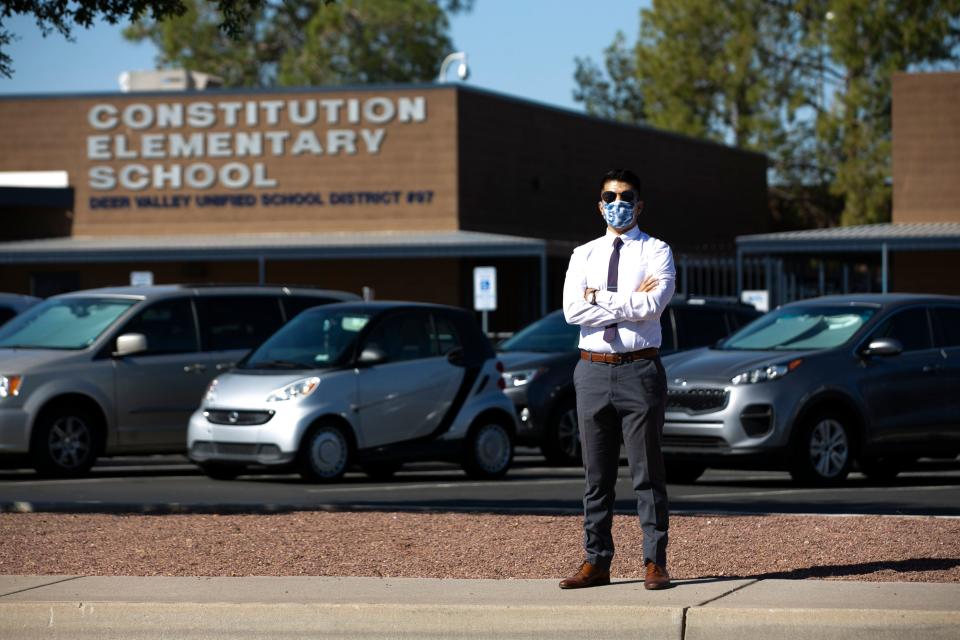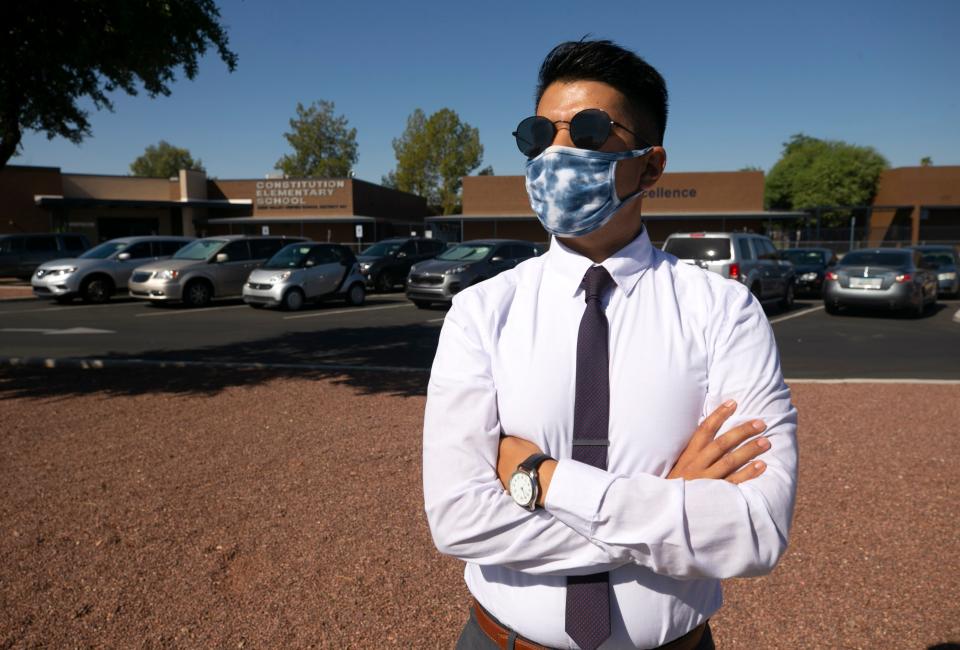These Arizona teachers quit this year, adding to the shortage of instructors. Here's why

PHOENIX — What once was a constant trickle of teachers fleeing Arizona classrooms has turned into a flood of departures because of the pandemic.
COVID-19's widespread impact on schools has highlighted a persistent teacher shortage in Arizona, one that's gone on for more than a decade.
In March, the pandemic forced teachers out of school. By August, many weren't sure if they wanted to come back, as the virus continued to spread in sometimes unpredictable ways.
The vast majority of Arizona teachers chose to teach again this school year, some even going back into the classroom as in-person classes begin again in more and more districts.
Since the 2020-2021 school year began, 751 teachers have resigned or quit, according to a survey from the Arizona School Personnel Administrators Association, compared with 427 in 2019. Of the 751 who left, 326 cited COVID-19 as their primary reason for leaving.
While COVID is the central theme in those resignations, educators' explanations for leaving differ widely, from health concerns to philosophical ones. Their reasons for leaving go beyond just returning to in-person school, which some teachers have said they don't oppose with the proper precautions.
Marisol Garcia, vice president of the Arizona Education Association, said educators are increasingly faced with competing decisions as caregivers, teachers and family members. Some don't feel comfortable returning to the classroom when family members at home are vulnerable to COVID-19.
"It's just a hard choice," she said. "Do you stay home with your children? Do you take care of your parents?"
Those same questions have been asked across the country. One-third of teachers nationwide told Education Week in July they were somewhat or very likely to leave their job this year, compared with just 8% who leave the profession in a typical year.
While that survey might reflect teachers' feelings over the summer, a review of the retirement and staffing figures collected in some of the first states to resume classes this year suggests that fears of a mass exodus of retiring teachers may have been overblown. It's a mix — Tennessee and Indiana, for example, have seen decreases in retirements, while states like New York and Arizona have seen increases.
More: Fears of a mass exodus of retiring teachers during COVID-19 may have been overblown
Still, even seasoned educators are having a hard time this year, because plans to reopen and close schools continuously shift.
The loss of educators, especially veteran ones on the precipice of retirement, is a grave loss, Garcia said.
"We will never recover," she said.
The Arizona Republic, part of the USA TODAY network, interviewed three educators who have left the profession in the backdrop of the pandemic.
Ruben Miranda
To get his instrumental music degree, Ruben Miranda learned how to play the oboe. And the clarinet. And the trumpet.
Earning the degree took years of work, but it landed him at the front of the classroom. As a band teacher, Miranda loved witnessing a student learn to play an instrument, from the beginning, when the instrument "doesn't sound so good," to their final years of school, when they play in concerts.
"I like watching them grow," he said.
Miranda taught music at at an elementary school in north Phoenix, up until late September, when he resigned.

When virtual school took the place of in-person school in the spring, Miranda said he dove "headfirst" into distance learning. As the new school year began virtually in August, he felt like he was using the right technology and effectively teaching music from afar.
Then, the district decided to go back earlier than he'd anticipated. Officials initially pledged to follow recommendations based on state health data.
The metrics measure COVID-19 spread: When spread is substantial, the state recommends virtual learning. When spread is moderate, the state recommends schools implement a hybrid model, which would mean fewer students on campus at one time. In the case of minimal spread, the state recommends normal, in-person schooling.
In Miranda's school district, spread was still moderate when officials announced a phased-in approach, which would have all students back on campuses by mid-October. For Miranda, the decision was a red flag.
The red flags stacked up. Because any student could come back if their families chose, Miranda expected full classrooms, upwards of 25 to 30 students. While district officials wrote online that they would strive to keep students spaced apart by six feet, they also acknowledged that six feet might not be feasible.
"Key factors were just kind of not really negotiable for me," he said. "It's either six feet or nothing in my opinion."
He requested a thermometer for his classroom and was told he wouldn't be able to use one because district policy stated that temperature checks are "not a valid predictor of COVID-19."
Miranda resigned the week students started to return to campus. He didn't believe the district was doing enough to stop the virus from spreading. He was OK with the idea of returning to campus in October but not without extensive safety measures.
Miranda found a job in higher education as a financial aid adviser. He'll consider returning to the classroom when there's a vaccine. But even as he settles into the new job, he's thinking of the teachers he left behind.
"They're living in fear right now, and it's not fair and it's not right," he said.
Lynn Vest
Lynn Vest wanted to work until she was 72.
Vest taught preschool students in special education programs in Gilbert, Ariz. She taught for 20 years after her kids were grown.
"I've taught every age group and every disability," she said.
In early August, Vest taught virtually for a week then went back in-person on Aug. 17, the earliest day the state would allow in-person school. She received one mask from the district that felt flimsy and did not fit her face. Vest planned to continue teaching, but during a trip to Utah, she developed blood clots in her lungs.
With the medical condition, the risks of contracting COVID-19 while teaching were too high. Vest retired at 65 — seven years earlier than planned.
"I'm just frustrated that the choice was taken away from me," she said.
The abrupt end to her teaching career is disappointing. Teaching fulfilled her in different ways: She loved witnessing the moment "the light bulb goes on" in students, when they put the pieces of a lesson together and it clicks.
Vest is not completely done teaching. When the pandemic slows, she wants to tutor students who need extra help, she said.
"The world is made up of so many different diverse minds," she said. "You just have to find a way that works for them." Until then, she's staying home.
Patricia Bryant
As summer turned into fall, Patricia Bryant worked 12-hour days going door-to-door for the U.S. Census. When the special education teacher applied for the Census position, she thought it was something she could do over spring break.
But when spring break came, so did COVID-19. She was working at a private school for students with autism in Cottonwood, Ariz. Bryant used as many online resources as she could find to help students while school was closed, she said.
The 69-year-old weighed her options for teaching when the new school year came around, but it seemed like most opportunities would eventually ask her to teach in-person.

Special education students, she was told, required in-person therapy. One district wanted her to be inches away from students.
After considering the risks to her age group, Bryant decided not to teach this year. She is trying not to dwell on the choice.
She's living on about $1,500 a month with retirement money, which is a challenge. She does not know if she'll return to the classroom. Closures, she said, have exposed to parents what it takes to teach.
"People now that are having to teach their kids at home have found out the hard way that you can't just walk in and say 'Here's a book, do this,'" she said. "It doesn't work that way."
Follow her on Twitter @LilyAlta.
Contributing: Elinor Aspegren, USA TODAY
This article originally appeared on Arizona Republic: Arizona teacher shortage persists amid COVID; why 3 quit in 2020

